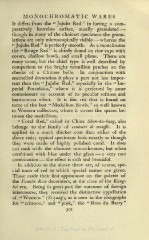Page 371 - Oriental Series Japan and China, Brinkly
P. 371
MONOCHROMATIC WARES
It differs from the "Jujube Red " in having a com-
paratively lustreless surface, usually granulated
though in many of the choicest specimens the granu-
tl"ahJteiuoj"nusRboearuRegeeodnlR"yeidms ip"cerriofssecccohtilpeyifcslaymlolfoyotuvhin.sdibolAens whereas the
a monchrome
rice cups with
covers, shallow bowls, and small plates. There are
many tones, but the chief type is well described by
comparison to the bright vermilion patches on the
cheeks of a Chinese belle. In conjunction with
enamelled decoration it plays a part not less impor-
" the " Im-
tant than the Jujube Red," especially in
perial Porcelains," where it is preferred by some
connoisseurs on account of its peculiar softness and
harmonious effect. It is this red that is found on
some of the best " Medallion Bowls," so well known
to Western collectors, where it covers the spaces be-
tween the medallions.
" Coral Red," called in China Shan-hu-hung, also
belongs to the family of couleurs de moujfle. It is
applied in a much thicker coat than either of the
above reds typical specimens look exactly as though
;
they were made of highly polished coral. It does
not rank with the choicest monochromes, but when
combined with blue under the glaze a very rare
combination the effect is rich and beautiful.
In addition to the above there are, of course, spe-
cial tones of red to which special names are given.
These made their first appearance on the palette of
the Famille Rose decorators, at the close of the Kang-
hsi era. Being in great part the outcome of foreign
intercourse, they received the distinctive appellation
" Western "
of (Si-yang), as is seen in the ideographs
" crimson," " "
for and pink," the " Rose du
Barry
301

